#northern white rhinoceros
Photo
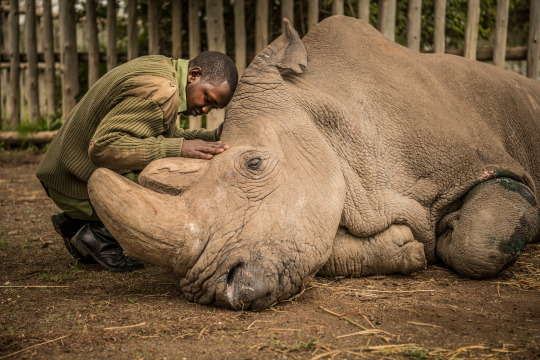
“March 19, 2023, marks the fifth anniversary of the death of Sudan, the last known male northern white rhino on the planet. Here, JoJo Wachira gives his last goodbye to Sudan before he died at Ol Pejeta Conservancy in northern Kenya.
It was silent, except for the rain falling, a single bird scolding, and the muffled sorrow of Sudan’s caretakers. Watching a creature die—one that is the last of its kind—is something I hope never to experience again. It felt like watching our own demise.”
- The words of photographer Ami Vitale, via her Instagram.
588 notes
·
View notes
Text

For the past two years, I've been illustrating every mammal on our planet. I've completed over 200 animals and now plan to create a book. In the book, I researched interesting facts about each animal, (Where they live, conservation status, evolutive paths, curiosities, etc).
To fund this project, I've established a monthly club offering various ways for people to support my work. One option is receiving monthly book updates in PDF format. This month's feature, for example, is the White Rhinoceros, and the book uniquely covers its subspecies, setting it apart from others.
There are more things than the book updates (There are actually a lot of things). If you feel that this speaks to you check out the club options by clicking here
Giving a like and sharing this post is also very helpful. Thanks all for the attention and see you soon.
#northern white rhinoceros#white rhino#rhinoceros#rinoceronte#rinoceronte blanco#extinct animals#illustration#drawing#scientific illustration#book of animals#infographic#illo#wild animals#wildlife#animals#artist on tumblr#extinction#conservation
151 notes
·
View notes
Text
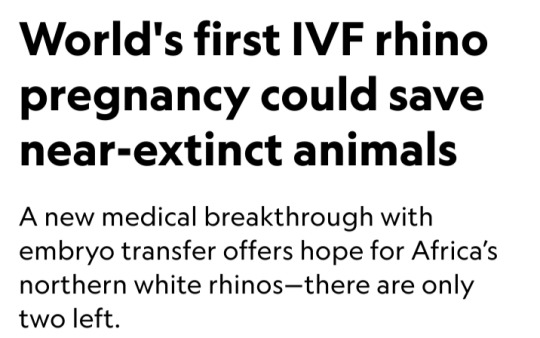

By Dina Fine Maron
January 24, 2024
Scientists have cleared a significant hurdle in the years-long effort to save Africa’s northern white rhinoceros from extinction with the first-ever rhino pregnancy using in vitro fertilization.
The lab-assisted pregnancy, which researchers will announce today, involved implanting a southern white rhino embryo in a surrogate mother named Curra.
The advance provides the essential “proof of concept” that this strategy could help other rhinos, says Jan Stejskal of the BioRescue project, the international group of scientists leading this research.
Curra died just a couple months into her 16-month pregnancy from an unrelated bacterial infection, Stejskal says.
However, the successful embryo transfer and early stages of pregnancy pave the way for next applying the technique to the critically endangered northern white rhino.
The process was documented exclusively by National Geographic for an upcoming Explorer special currently slated to air in 2025 on Nat Geo and Disney+.
BioRescue expects to soon implant a northern white rhino embryo into a southern white rhino surrogate mother.
The two subspecies are similar enough, according to the researchers, that the embryo will be likely to develop.
Eventually, this approach may also help other critically endangered rhinos, including the Asian Javan rhinoceros and the Sumatran rhinoceros, which each now number under 100 individuals, Stejskal says.
But the northern white rhino’s current situation is the most pressing by far.
There are no males left, and the only two remaining animals are both elderly females that live under armed guard on a reserve in a 700-acre enclosure in Kenya called Ol Pejeta Conservancy.
The boxy-jawed animals once roamed across central Africa, but in recent decades, their numbers have plummeted due to the overwhelming international demand for their horn, a substance used for unproved medicinal applications and carvings.
Made from the same substance as fingernails, rhino horn is in demand from all species, yet the northern white rhino has been particularly hard-hit.
"These rhinos look prehistoric, and they had survived for millions of years, but they couldn’t survive us,” says Ami Vitale, a National Geographic Explorer and photographer who has been documenting scientists’ efforts to help the animals since 2009.
“If there is some hope of recovery within the northern white rhino gene pool — even though it’s a substantially smaller sample of what there was — we haven’t lost them,” says conservation ecologist David Balfour, who chairs the International Union for the Conservation of Nature’s African rhino specialist group.
Blueprints for rhino babies
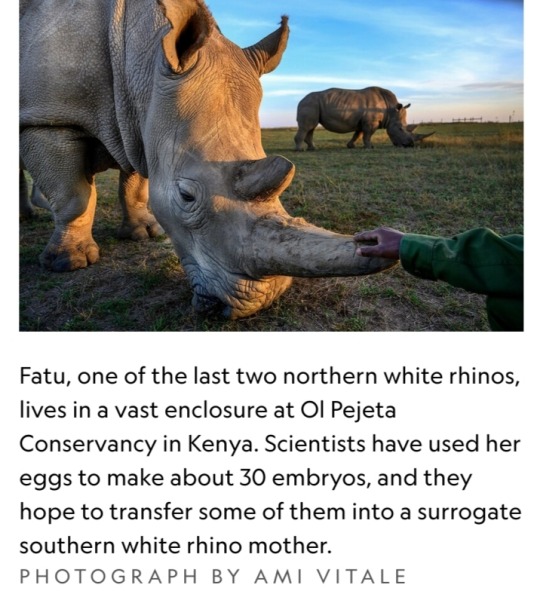
To stave off the animal’s disappearance, BioRescue has used preserved sperm from northern white rhinos and eggs removed from the younger of the two remaining females.
So far, they’ve created about 30 preserved embryos, says Thomas Hildebrandt, the head scientist of BioRescue and an expert in wildlife reproduction based at the Leibniz-Institute of Zoo and Wildlife Research in Berlin.
Eventually, the team plans to reintroduce northern white rhinos into the wild within their range countries.
“That’d be fantastic, but really, really far from now—decades from now,” says Stejskal.
Worldwide, there are five species of rhinoceros, and many are in trouble.
Across all of Africa, there are now only about 23,000 of the animals, and almost 17,000 of them are southern whites.
Then there are more than 6,000 black rhinos, which are slightly smaller animals whose three subspecies are critically endangered.
In Asia, beyond the critically endangered Javan and Sumatran rhinos, there’s also the greater one-horned rhino, whose numbers are increasing and currently are estimated to be around 2,000.
The BioRescue effort has experienced many setbacks, and even though the team now has frozen embryos, the clock is ticking.
The researchers intend to use southern white rhinos as surrogate moms for the northern white rhino embryos.
However, scientists want any northern white rhino calves to meet and learn from others of their kind, which means they need to be born before the two remaining females die.
“These animals learn behaviors — they don’t have them genetically hard-wired,” says Balfour, who’s not involved with the BioRescue work.
But birthing new animals in time will be a challenge.
“We’re really skating on the edge of what’s possible,” he says, “but it’s worth trying.”
Najin, the older female, will be 35 this year, and Fatu will be 24.
The animals, which were born in a zoo in the Czech Republic, are expected to live to about 40, says Stejskal, who also serves as director of international projects at the Safari Park Dvůr Králové, the zoo where the animals lived until they were brought to Kenya in 2009.
Impregnating a rhino
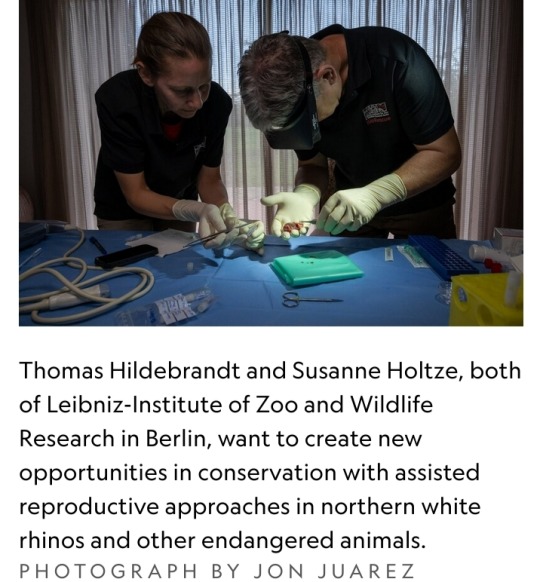
The next phase of BioRescue’s plan involves implanting one of their limited number of northern white rhino embryos into a southern white rhino surrogate mother — which the group plans to do within the next six months, Stejskal says.
They’ve identified the next surrogate mother and set up precautions to protect her from bacterial infections, including a new enclosure and protocols about disinfecting workers’ boots.
But now, they must wait until the female rhino is in estrus — the period when the animal is ready to mate — to implant the egg.
To identify that prime fertile time, they can’t readily perform regular ultrasounds at the conservancy as they might do in a zoo.
Instead, they have enlisted a rhino bull that has been sterilized to act as a “teaser” for the female, Hildebrandt says, adding that they must wait a few months to make sure that their recently sterilized male is truly free of residual sperm.
Once the animals are brought together, their couplings will alert conservancy staff that the timing is right for reproductive success.
The sex act is also important because it sets off an essential chain of events in the female’s body that boosts the chances of success when they surgically implant the embryo about a week later.
"There’s little chance the conservancy staff will miss the act. White rhinos typically mate for 90 minutes," Hildebrandt says.
What’s more, while mounted on the females, the males often use their temporary height to reach tasty plant snacks that are generally out of reach.
Boosting genetic diversity
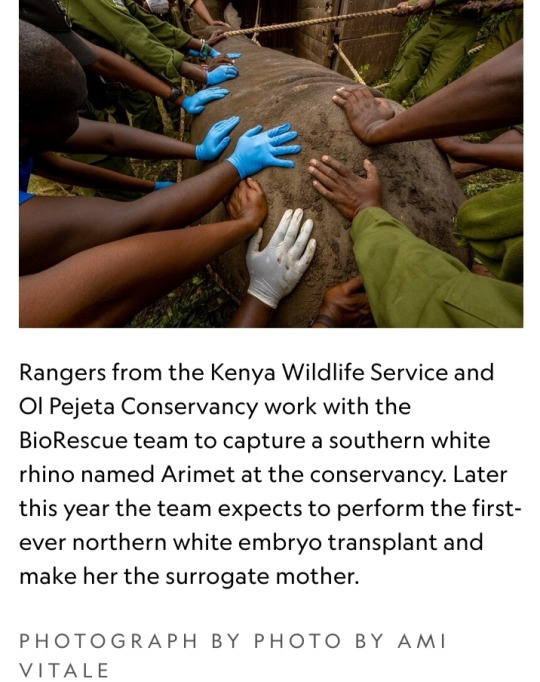
With so few northern white rhinos left, their genetic viability may seem uncertain.
But the BioRescue team points to southern white rhinos, whose numbers likely dropped to less than 100, and perhaps even as few as 20, due to hunting in the late 1800s.
Government protections and intense conservation strategies allowed them to bounce back, and now there are almost 17,000.
“They have sufficient diversity to cope with a wide range of conditions,” says Balfour.
Researchers don’t know exactly how many southern white rhinos existed a century ago, he says, but it’s clear that the animals came back from an incredibly low population count and that they now appear healthy.
Beyond their small collection of embryos, the BioRescue team hopes to expand the northern white rhino’s gene pool by drawing from an unconventional source — skin cells extracted from preserved tissue samples that are currently stored at zoos.
They aim to use stem cell techniques to reengineer those cells and develop them into sex cells, building off similar work in lab mice.
According to their plan, those lab-engineered sex cells would then be combined with natural sperm and eggs to make embryos, and from there, the embryos would be implanted into southern white rhino surrogate mothers.
Such stem cell reprogramming work has previously led to healthy offspring in lab mice, Hildebrandt says, but rhinos aren’t as well-studied and understood as mice, making this work significantly challenging.
A global effort
The northern white rhino revitalization venture has cost millions of dollars, supported by a range of public and private donors, including the German Federal Ministry of Education and Research.
Other partners on the effort include the Leibniz Institute for Zoo and Wildlife Research, the Czech Republic’s Safari Park, Kenya Wildlife Service, Ol Pejeta Conservancy, and also Katsuhiko Hayashi, a professor of genome biology at Osaka University in Japan who conducted the mouse stem cell research.
Building upon Hayashi’s stem cell techniques could ultimately bring the northern white rhino gene pool up to 12 animals — including eggs from eight females and the semen of four bulls, according to Stejskal.
An alternative approach to making more babies, like crossbreeding northern and southern white rhinos, would mean the resulting calves wouldn’t be genetically pure northern white rhinos, Hildebrandt notes.
The two subspecies look quite similar, but the northern version has subtle physical differences, including hairier ears and feet that are better suited to its swampy habitat.
The two animals also have different genes that may provide disease resiliency or other benefits, Hildebrandt says.
There are unknown potential differences in behavior and ecological impact when populating the area with southern white rhinos or cross-bred animals.
"The northern white rhino is on the brink of extinction really only due to human greed,” Stejskal says.
“We are in a situation where saving them is at our fingertips, so I think we have a responsibility to try.”
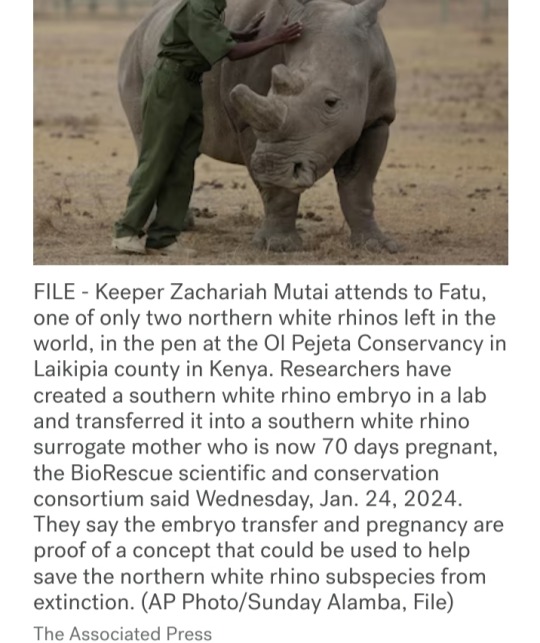
🩶🦏🩶
#northern white rhinoceros#rhino embryo transfer#in vitro fertilization#IVF#southern white rhinoceros#critically endangered animals#National Geographic#BioRescue#rhino horn#International Union for the Conservation of Nature#African rhino specialist group#Thomas Hildebrandt#German Federal Ministry of Education and Research#Leibniz Institute for Zoo and Wildlife Research#Kenya Wildlife Service#Ol Pejeta Conservancy#Katsuhiko Hayashi#genome biology#IVF rhino pregnancy
8 notes
·
View notes
Text
🦏
1 note
·
View note
Text
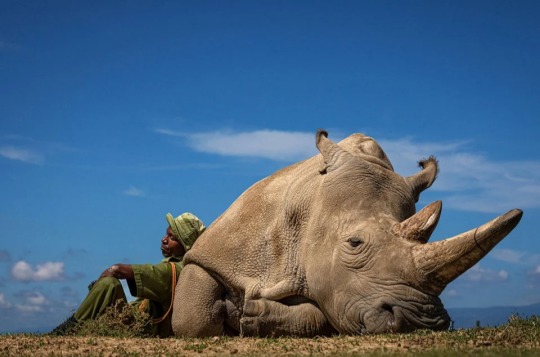
One of the last two Northern White Rhinoceros being guarded 24/7 from poachers.
0 notes
Text
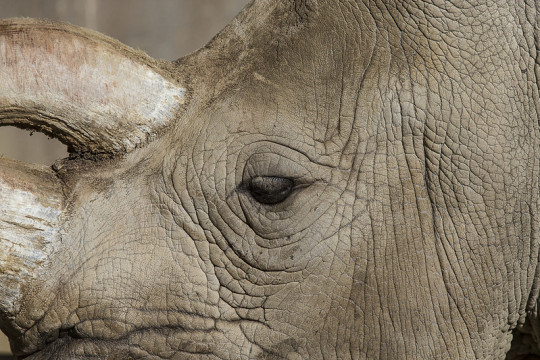
Critically endangered Northern White Rhino (Ceratotherium simum cottoni), Nola. At the time of her death, Nola was one of the last four northern white rhinos left in the world, housed at San Diego Safari Park, California.
by San Diego Zoo Wildlife Alliance
#northern white rhino#white rhinoceros#rhinoceros#rhinos#ceratotherium simum cottoni#ceratotherium simum#ceratotherium#Rhinocerotidae#perissodactyla#mammalia#chordata#captive animal#san diego zoo#details
26 notes
·
View notes
Text
#rhinos#northern white rhino#rhinoceros#endangered animals#endangered species#good news#science#environmentalism#nature#environment#animals#conservation#africa
12 notes
·
View notes
Photo

Two critically endangered northern white rhinos.
© Ami Vitale
12 notes
·
View notes
Text
𝐓𝐡𝐞 𝐒𝐢𝐞𝐠𝐞 𝐨𝐟 𝐭𝐡𝐞 𝐍𝐨𝐫𝐭𝐡, 𝐩𝐚𝐫𝐭 𝟐
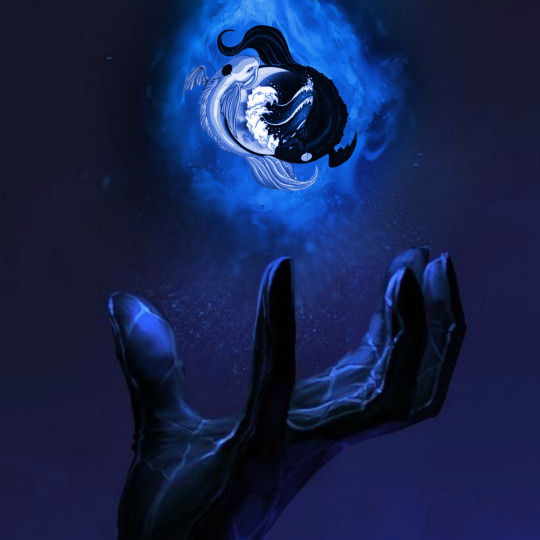
A/N: This mf long. Hope y'all enjoy, tho 🩵
Narrative
four massive fireballs arcing over the Water City walls and into the city. It is daylight, and the battle for the survival of the Northern Water Tribe has begun in earnest. The four fireballs land at various points within the city and explode. Back to the sanctuary, where Appa and the others are, the black and white fish circling each other in the sanctuary pond. Katara sits sadly in front of it, with tears in her eyes, Aang has been taken by Prince Zuko.
Above the waterfall, the Moon Warriors are perched on their polar bears on the frigid tundra, keeping an eye on Katara, Sokka, and Yue. They get on the flying bison and soar above them to find Aang. Lilia, Yanna's third command, motions for three Warriors to go protect them while the rest guard the oasis.
- Time Skip-
Yanna and her mother rushed to save women and children. Many Moon Warriors are fighting with the Northern tribe, taking down soldiers on rhinos and catapulting fireballs against the wall. The women gasped as they watched the Warriors take down the soldiers, Yanna covered a woman holding a small child. She covered her face and told them to stay put and take cover.
The Fire Nation assault on the city below. A line of Fire Navy ships abuts the outer wall, which continues launching fireballs deep into the unoccupied portions of the city. The invaders have penetrated the outer wall with infantry and armor. The Water Tribe still holds one of the towers in the foreground, but it is clear the defenders are losing this battle.
A couple of Fire Nation war rhinoceros, each with small catapults on either side of its saddle. One after the other, the soldiers on the rhinoceros fire their catapults.
Yanna and her sister waterbends tall structures around the houses of women and children. She waterbends the snow up and pushes the soldiers back away from the second wall. The secondary wall still holds a thin moat of water in front of it. The defenders are few, however, and a deadly rain of fireballs spreading destruction deep inside the city, Fire Nation tanks, firing as they advance toward the secondary wall.
Yanna looks up into the black, smoke-filled sky, and then the sky turns red. Yanna's heart sunk as she gazed at the now-red moon. She stared at the Northern Waterbenders, who had lost their ability to bend. Something has happened to the moon spirit, and the fire balls then penetrate the second wall, forcing the benders to flee.
The Moon Warriors formed a defensive line in front of the second wall, and Yanna felt wrath wash over her. Yanna's eyes began to glow as she moved her hands, as did the Warriors in a circular motion. They carved a hole in the ice, causing a few soldiers to stumble through. The sky then darkened to grey, Yanna's eyes blazed with rage as she realized what had just occurred; the moon spirit had been destroyed.
As she lifts her hands and cries, "RISE!" Hot tears streaming down her face. When the ice begins to quiver and shatter, the Fire Benders cease firing.
Seconds pass before the serpent emerges from the ice, leans down, and Yanna leaps upon the serpent, raising her swords into the air, "FOR THE WATER TRIBE, ATTACK!" The Warriors charge the army on their polar bears, while Yanna swipes her swords, taking out soldiers, tanks, and catapults.


A glow spreads from behind the citadel to encompass the entire citadel area of the city. A huge, incandescent blue wave rushes under the footbridge as if some huge creatures were moving underneath it. Appa stands on the oasis, but he is dwarfed by the creature that rises from the pool, the citadel, and the city visible beyond it.
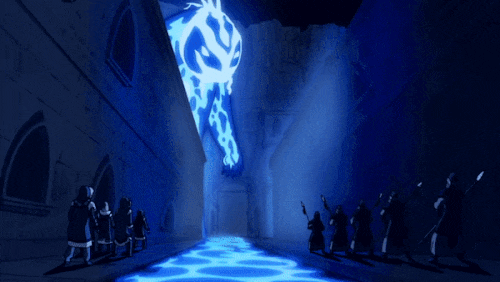
The blue, white veined creature is a huge fish like being. At its center is a blue white bubble, and there is Aang, who spreads his arms wide. A moment later, the Ocean Spirit, for this is truly he in communion with the Avatar, duplicates the motion. The Fire Nation soldiers who stand in front of the last wall, who back away in fear, start to run back to their ships. The Ocean Spirit towers over the citadel, its arms still spread wide, its blue spirit lighting the city like a beacon. The Spirit begins to move down into the city. Master Pakku and his waterbenders instantly bow to the floor in honor of their god. Across the canal, some Fire Nation soldiers raise their spears in defiance but are swept away by a wall of water sent by the Ocean Spirit. Aang inside the body of the Ocean Spirit, flailing his arms about, directing the power of the Ocean Spirit against the violators of the Moon Spirit and the Water Tribe City.
The Moon Spirit looks down at the Moon Warriors and motions for them to follow it to the ocean. Fire Nation tanks fire blasts of fire at the Ocean Spirit, but they are absorbed with no effect. The soldiers and tanks are washed away as if they were toys. The Ocean Spirit passes by the Water Tribe citizens who make obeisance to their lord. The Fire Nation army in full retreat, trying desperately to escape the vengeance of a living Spirit. The Ocean Spirit reaches the main canal in front of the third wall and melts into it.
The Moon Warriors and the Moon Spirit make it to the ocean. Yanna, on her serpent take down Fire Nation ships while the Moon Spirit pushes the rest of them back. The Moon Spirit looks at the pushed backed ships and dissipates back into the water. The Spirit lifts out the water and puts Aang back on the wall, causing him to fall to his knees. The Spirit then goes back into the water and spirals around, lifting Yanna into the air.
"YOU WILL BE RESPONSIBLE FOR THE CRIMES YOU COMMITTED TODAY! FIRE LORD OZAI WILL FALL TO HIS KNEES AND PAY FOR THE WORLD'S DESTRUCTION! LEAVE AND NEVER RETURN!" Yanna said assertively. The spirit placed Yanna back on the serpent and vanished back into the water.
-Time Skip-
Yanna's pov
I watched the Northern Water Tribe and my Warriors starting to rebuild the structure of the city. I looked at Arnook and grabbed his hand. He looked down at me with sad eyes while i gave him a sympathetic smile. He looked back up to the Moon and said, "The Spirits gave me a vision when Yue was born. I saw... a beautiful, brave young woman... Become the Moon Spirit." He Closes his eyes and signs deeply, "I knew this day would come." He said, doeful
"You must be proud." I said. He smiled, and quietly said, "So proud. And sad."
I looked at Aang, Katara, and Sokka, hugging beside their bison. My heart wanted me to go talk to them, but I don't know what I would say. It's been years since I've spoken to them, I was a little girl the last time I spoke to them, I'm 18 now. I felt Arnook looking down at me, and he smiled, grabbing my hand. He turned back to the people and began to speak. "Great People Of The Water Tribe, we just fought the greatest fight our people have ever encountered, I would like to thank THE GREAT MOON AND OCEAN SPIRITS FOR GUIDING US AND FOR GIVING US STRENGTH TO WIN THIS BATTLE! But most importantly, I would like to thank the Avatar and thank the people who we thought were legends. PLEASE EVERYONE BOW BEFORE THE MOON WARRIORS WHO SHOWED INCREDIBLE STRENGTH AND POWER, MAY IMIQ CONTINUE TO BLESS US!"
I watched everyone bow before me before my Warriors. I felt joy and pride in my heart, that I had done my people proud, that I've done my father proud. Arnook nudged me to speak, and I walked down the steps in front of the people, and in front of Sokka and Katara.
"I am Yanna, the Moon Warriors' leader and the daughter of Tarak and Myra. I was chosen by our previous Avatar, Imiq. At a young age, I had no idea I had so much power and responsibility at the time. My father would often tell me that I was destined for greatness, but I never knew what he meant. Every day, we would train, and I had no idea he was preparing me for who I was meant to be.
The day the Fire Nation arrived at the South Pole was the darkest day of my life. It was the day I lost my father. I had to abandon my friends and fully isolate myself from the rest of the world in order to become powerful enough to protect both the south and north poles.
I've questioned whether I was giving my all mentally, physically, and emotionally. I felt like a failure every day, until one day I realized I couldn't feel sorry for myself anymore. My people were counting on me. Every day, I trained and fought hard. There were days when I stumbled, but I always got back up. Because that is what a leader does—they do not give up when things get difficult.
When life knocks you down, you get back up and keep pushing until you can't anymore, and even then, you try again." I felt tears brim my eyes as I raised my fist to my chest.
"I am proud to be a member of the Water Tribe, a Moon Warrior, and most importantly, I am proud of the Avatar for returning to us. And I'd want to thank my fellow brother and sister, Sokka and Katara, for bringing him to us. As long as there is air flowing through my lungs, there isn't a challenge or fight I'm not willing to face," I said, raising my fist in the air. "MAY THE GREAT SPIRITS KEEP SHINING ON US!"
Everyone raised their fists and chanted. I looked at Katara, who was crying, and Sokka, who was smiling slightly. I approached them while standing in front of them. My chest felt heavy as I opened my mouth to say something, but it wouldn't come out. Katara then grabbed my hands and pulled me into a hug, causing me to sob, then I felt Sokka wrap his arms around me and Katara, too. "I missed you, Yan." Katara said. I kissed her cheek and said, "I've missed you more, Tara."
#black reader#black writers#black tumblr#self post#tumblelog#black girls#black representation#poc reader#poc writer#black excellence#atla#avatar the last airbender#avatar aang#atla sokka#sokka x black reader#atla katara#atla zuko#zuko x black reader#toph atla#finding peace#paisholotus#atla x black reader#avatar last airbender x black reader
40 notes
·
View notes
Video
“Nola”, a 40 year old northern white rhinoceros, is attended to by a veterinarian and keepers at the San Diego Zoo Safari Park (2014). At the time, she was one of the last five northern white rhinos on Earth, and the very last exhibited in North America.
[ RHINO WITH A RUNNY NOSE: Rare rhino undergoes veterinary exam at San Diego Zoo Safari Park by San Diego Zoo Wildlife Alliance ]
#Northern white rhinoceros#Northern white rhino#Mammal#FE#EW#Photo#Live specimen#Captive#Nola#Upload
100 notes
·
View notes
Text

I've been creating all these animal illustrations for my upcoming book centered around the fascinating world of mammals. I've launched an exclusive club that offers three different membership tiers, each with awesome rewards.
Click here to see more.
Thank you, guys! Love you all and have a nice week. More animals to come soon.
Northern White Rhinoceros
Only two of these animals remain. The last male, named Sudan, passed away in 2018 due to age-related complications. With Sudan's death, this species is functionally extinct and now relies on various assisted reproductive techniques facilitated by humans.
#white rhino#northern white rhinoceros#illustration#drawing#scientific illustration#book of animals#animals in art#illo#wild animals#wildlife#artist on tumblr#mammals#animals of tumblr#extinct animals#endangered species
91 notes
·
View notes
Text

OK so I actually have a better answer, now. The other post, where I initially responded to this message, addresses the forests of the Fertile Crescent, the effects of devegetation on other large creatures (tigers, elephants, etc.) that historically lived in the Levant and Mesopotamia, the extinction of rhinos in most of China, and the possibility that Stephanorhinus (a Pleistocene rhino from a now-extinct genus) survived until the early Holocene. But here, I want to talk about rhinos in North Africa. In my initial response, in naming Stephanorhinus hemitoechus as a potential inhabitant of the Middle East, I was distracted and thinking about rhinos living in the Levant/Assyria and Mesopotamia specifically. If the question is “have rhinos lived in the Middle East during the Holocene?” ... then I think it’s important to emphasize this: The extinct Ceratotherium mauritanicum (in the same genus as white rhinos) and the still-living Ceratotherium cottoni (the “northern white rhino” or “Nile rhino”) were both alive in Morocco and Algeria during the Holocene. And the northern white rhino probably survived in the Sahara for longer. Holocene rock art across the Sahara depicts rhinos. Some petroglyphs, perhaps as young as 7,000 years old, depict rhinos in Morocco, Libya, and Egypt.
Short answer: There were white rhinos, possibly two different species of white rhinos, living in North Africa and near the Mediterranean coast in the Holocene long after the construction of Gobekli Tepe.
The “rhinos of the Middle East” are white rhinos. Within a matter of a few years, they will no longer exist on this planet.
As of 2022, there are only two remaining northern white rhinos left alive. This species will be extinct, vanished, very soon, within our lifetimes.
And it turns out that this so-called northern white rhino, Ceratotherium cottoni, seems to have inhabited Egypt, Libya, Algeria, and the Mediterranean coast of North Africa during the early Holocene.


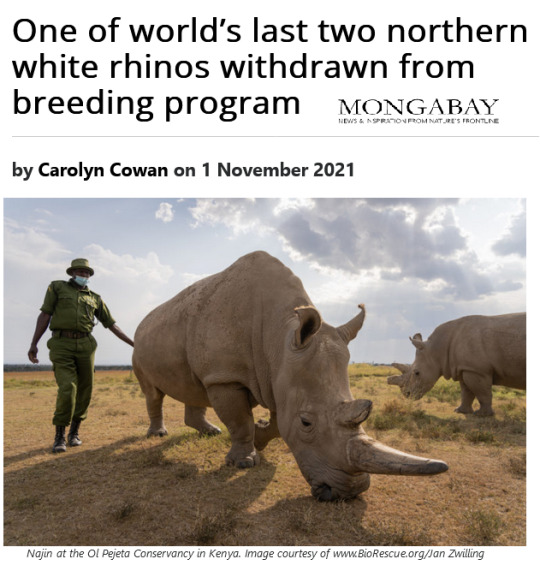
In media campaigns and textbooks, this creature has long been a prominent example of a “critically endangered species.”
The “northern white rhino” is also called the “Nile rhino”. This creature a unique subspecies, Ceratotherium simum cottoni. However some researchers instead consider it to be a unique species of its own, Ceratotherium cottoni. In 2018, “Sudan,” the last male of the species, passed away. The two remaining northern white rhinos, Fatu and the older Najin, are both over the age of 20. In October 2021, Najin was “retired,” or determined to be ineligible for breeding.
---
We have no evidence that Stephanorhinus survived into the Holocene, or any later than 14,000 years ago. But if we consider the wider “Middle East” and incorporate the Mediterranean coast of North Africa, then rhinos were still present until at least 9,500-ish years ago. Long story short:
Basically, even if Stephanorhinus went extinct before the end of the Pleistocene, Ceratotherium mauritanicum could have been alive on the Mediterranean coast of North Africa for several thousand more years. And then even if Ceratotherium mauritanicum went extinct at the beginning of the Holocene, it remains possible that remnant populations of the still-living northern white rhino lived in North Africa (since we know they previously lived across the entire region as far as Morocco). Finally, even the still-living black rhino may have lived farther north into Egypt before the ascent of the Old Kingdom.
Ancient rock art of a rhino in the Draa valley of Morocco:
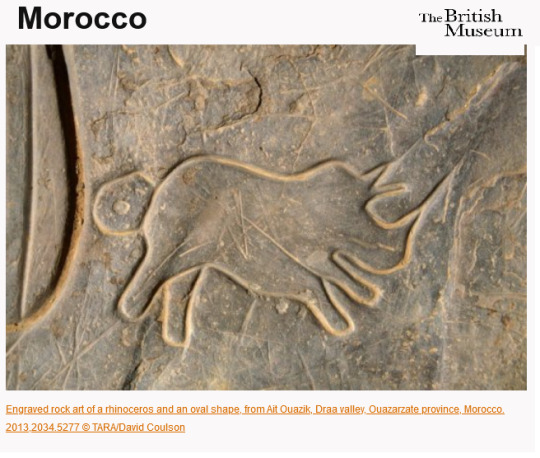
The rhinos depicted in the early-Holocene rock art could be either the extinct C. mauritanicum or locally-extinct populations of the extant white rhino.
Furthermore, considering the “Green Sahara” of the middle Holocene was much wetter and featured savanna landscapes, the still-living black rhinoceros may also have had a wider distribution, at least up until the time that the Sahara began to dry again which coincidentally aligns with the time of earliest dynastic Egypt. White rhinos (both the extinct C. mauritanicum and the living white rhinos) seem better adapted to dryland environments, like those of the Sahara and North Africa. And black rhinos seem more associated with seasonal woodland and more-vegetated landscapes. But the “Green Sahara” may have suitable to some black rhinos.
However, rhinos remain conspicuously absent from Egyptian depictions of the lower Nile. Therefore, I doubt rhinos persisted anywhere near the Fertile Crescent after 3000 BC.
Here’s the “Green Sahara” landscape, featuring “Lake Mega-Chad” and large areas of vegetated savanna and wetland:
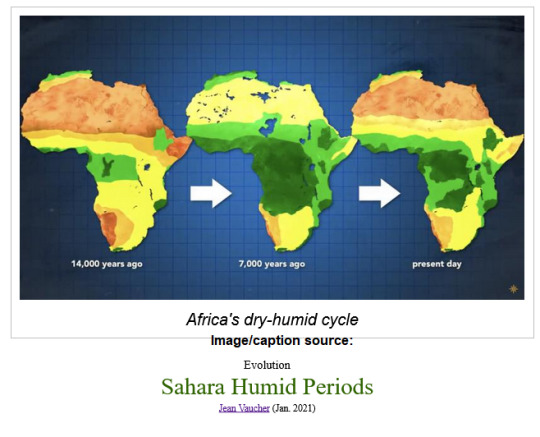
---
So here’s the geographical gap we’re talking about.
And this might appear conspicuous, given that within human history, other large mammals like elephants lived in both Africa and Asia and also in the Fertile Crescent between them; lions and cheetahs and leopards lived in both Africa and Asia and also in the Fertile Crescent between them.
Distribution map of the 6 living species/subspecies of rhinoceros (made with working-class GIS, MS Paint, lol):
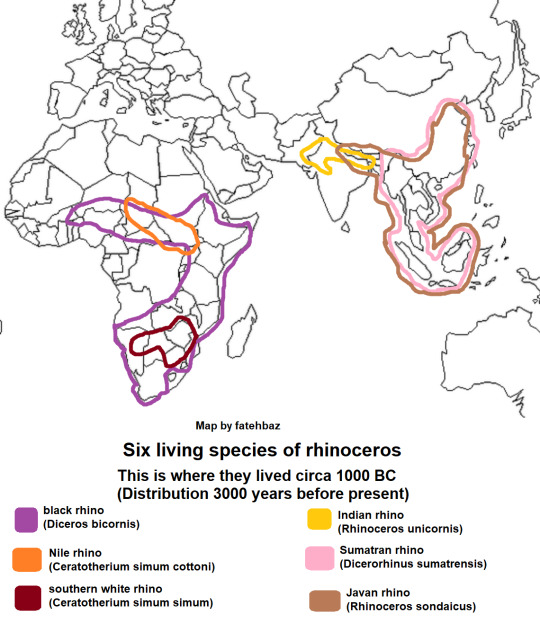
That’s what rhino distribution looks like “in history.” Today, rhinos are extinct across like 99% of all of that distribution range, though.
Anyway, here’s what the Late Pleistocene in North Africa looks like.
Note that I haven’t included the woolly rhino, the Siberian unicorn, or Stephanorhinus mercki, all three of which lived farther north in Europe, Central Asia, and northern East Asia.

Note that at 12,000 years ago, the northern white rhino’s distribution is wider than it is today.
Even the straightforward W!ikipedia article about Ceratotherium mauritanicum explicitly proposes that the rhino was still alive during the “earliest Holocene” and disappeared “by the Mesolithic.” Now, even when following-up with academic sources, I have questions about how the distinction between two species is being made. Here’s what we know:
- Ceratotherium mauritanicum was definitely alive during the Late Pleistocene, and maybe later, and was definitely present in Morocco.
- The closely-related Ceratotherium cottoni, the still-living “northern white rhinoceros,” was also living in Morocco and northern Algeria during the Late Pleistocene, alongside C. mauritanicum.
- Rhinos are depicted in ancient artwork/petroglyphs from the early Holocene in Morocco.
My question is: If C. mauritanicum and C. cottoni (a still-living species) were so closely-related and living in the same place, can we really know which species of rhino is depicted in the ancient rock art?
Furthermore, it’s still possible, also, that the still-living black rhinoceros ranged further northward in the “Green Sahara” during the early Holocene. It has been suggested that some rock art in Egypt, east of the Nile, depicts the black rhino, but I don’t know where this oft-repeated claim comes from?
So finally, this is my guess at the presence of rhinos by the time of pre-dynastic Egypt:
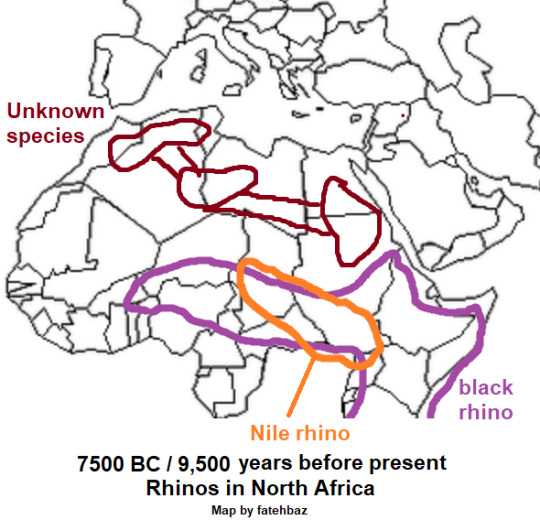
Anyway, if you want to do some research, these are sites with artwork depicting rhinoceros from pre-dynastic and/or early dynastic Egypt, the early Mesolithic, “Bubalus” style locations, or the early Holocene generally (from maybe 8000 years before present, or younger):
L’Assif N’Talaisane in the High Atlas of Morocco; Yagour in the High Atlas of Morocco; Messak-Tadrart area of Libya; Aramat area of Libya; Gilf Kebir in Egypt
Elephants are even more common in early Holocene art from the Sahara. A lot of these sites also have petroglyphs of giraffes, too, including the “Giraffe Caves” at Gebel Uwaynat at the Egypt-Sudan frontier.
A giraffe in ancient rock art in Libya:
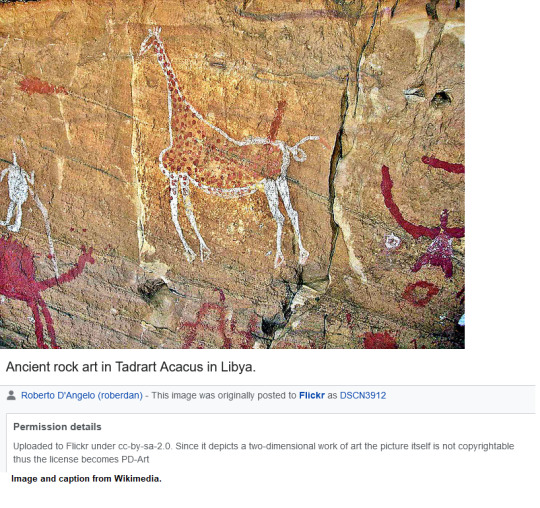
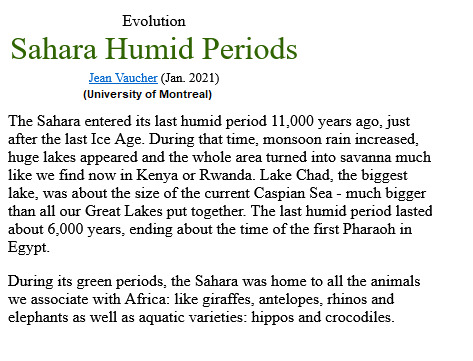
“The last humid period [...] end[ed] about the time of the first Pharaoh in Egypt.”
Even without rhino presence, here’s the milieu of creatures known to be present in the eastern Mediterranean in the Holocene up until at least the Bronze Age:
Asian elephant (in Assyria, eastern Anatolia, and Mesopotamia); African elephant (in Nubia, Kush, Punt and probably also in Algeria until Rome’s conquering of Carthage); aurochs; hippopotamus (in Nile delta, Sinai, and at times in Phoenicia/Lebanon); gazelles; Arabian oryx; Asiatic lion (widespread, including Greece and Balkans until 500 BC and Mesopotamia until 20th century); Caspian tiger (in eastern Anatolia, the Caucasus, Hyrcania, Kwarazmia, in some places until the mid-20th-century); Arabian leopard and Persian leopard (both still present); caracal; cheetah (widespread though probably intermittent, still alive in Persia); Syrian ostrich (now extinct); sacred crocodile (in Nile delta, coastal Palestine, and isolated oases in Tunisia and Morocco)
---
Anyway. After the construction of Gobekli Tepe, after the decline of (most!) woolly mammoths, after the end of the Pleistocene, as “civilizations” emerged in Egypt and Mesopotamia, was there a rhinoceros that lived naturally in the eastern Mediterranean? Probably, yes. The white rhino. Maybe two different kinds of white rhinos. But they were probably gone by the time of dynastic Egypt. And of that entire lineage of North African white rhinos, only two individuals survive on the planet today.
We will live to see the final end of North African white rhinos.
133 notes
·
View notes
Text

White rhinoceros (Ceratotherium simum)
These armoured beasts are the largest living rhinos. They’re found in dry African savannas, wallowing in the mud to cool themselves down. Today, they’re only found in Southern Africa. The story of the white rhinoceros is rather tragic- there are two subspecies, one northern and one southern. Both were overhunted in the 19th century, and the southern white rhino was reduced to less than 50 individuals by 1895. But it has made a grand comeback due to conservation efforts, today the most populous rhino species with more than 18,000 individuals in the wild alone. On the other hand, the northern white rhinoceros never recovered, and only two individuals are known to be alive today- both female. The only hope for this subspecies is if an unknown wild population remains, or if assisted reproduction technology can be used to create more males.
#markhors-menagerie#animal facts#animals#biology#fun facts#ungulates#odd toed ungulates#rhinoceros#white rhinoceros
6 notes
·
View notes
Photo
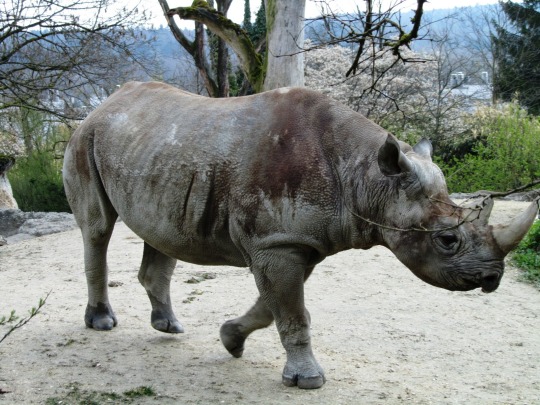
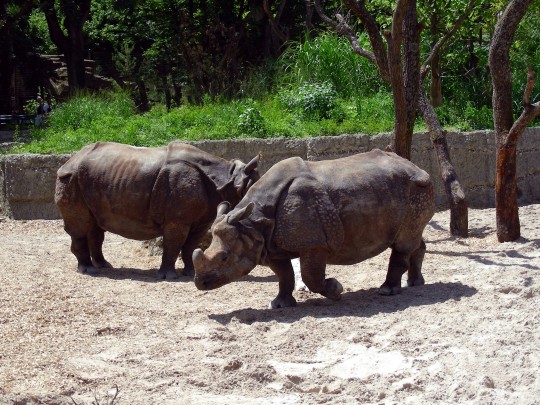




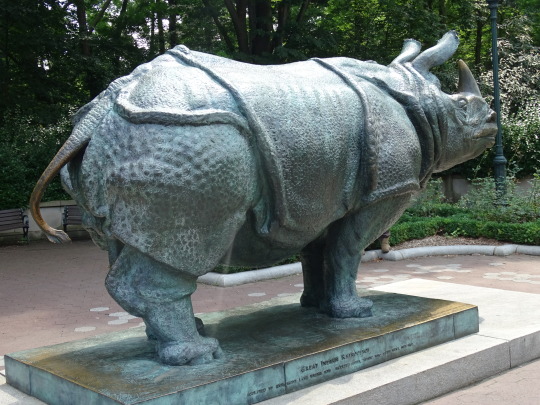
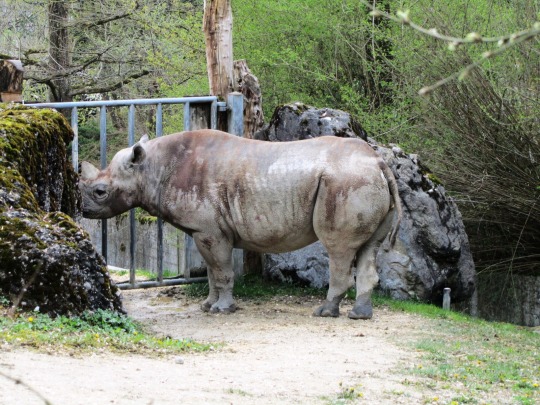


Save The Rhino Day
Save the Rhino Day, celebrated globally on May 1, is a day centered around raising awareness of the rhino’s plight in the world, and highlighting ways to help this incredible animal. This day is especially important given the current devastating statistics — on average, one rhino is poached somewhere in the world every 22 hours. On this day, various animal rights organizations, non-profit companies, zoos, animal activists, and other concerned groups provide opportunities to encourage more rhino conservation efforts from people around the world.
History of Save The Rhino Day
To trace the origins of the Rhinoceros, we’d have to go back some millennia — almost 56 million years ago, to be precise. That’s when the first ancestors of the modern Rhinos roamed the planet. They were more horse-like in structure and had no horns. Old rhino bones found from this period in North America show a gradual evolution from this old horse-like structure into one more aligned with today’s rhino. Over these years, there were three distinct species that scientists think might be the ancestors of today’s rhinos. One of these was called the ‘running rhino,’ which was adapted for speed.
Another was more aquatic and resembled today’s hippopotamus. The last, most direct ancestors to the modern rhinoceros appeared approximately 25 million years ago and had multiple sub-species in their families. Of these, the wooly rhinoceros was one of the largest subspecies, weighing in at almost four times the size of the average African elephant, and boasting one-meter-long horns. This species inhabited a large area, from Siberia to the British Isles. These plant-eaters lived alongside the wooly mammoths, and have been found fossilized in ice and in cave paintings made during that period.
These rhinos only lived in Asia initially but began traveling to other places around 25 million years ago. Over time, these rhino ancestors roamed the continents, primarily living in Eurasia (Europe and Asia combined) and North America. However, the American rhinos went extinct sometime between 5.4 and 2.4 million years ago.
Rhinos have also featured in many Asian and African legends — they are the fire-stamping heroes in many stories from Burma, India, and Malaysia. According to these stories, rhinos appeared every time a fire was lit in the forest and would stamp out the flames. So popular is this tale that it even featured in a popular 1980 South-African movie named “The Gods Must Be Crazy.”
Unfortunately, these once-abundant creatures have lost out to human activity. Hunting, and now, poaching and habitat loss, have drastically reduced the number of rhinos across the world. Rhino horns are also integral to traditional medicine in many parts of Asia, with people believing it has mystical powers. Since 2007, there has been a sharp increase in poaching activity and illegal trade of rhino horns, to the extent that many subspecies of rhinos have been declared extinct and the entire rhino population is listed as ‘endangered’.
Save The Rhino Day timeline
1973 A Symbol of Queer Identity
Two Boston artists, Daniel Thaxton and Bernie Toale create a lavender rhinoceros as a symbol to increase awareness of gays and lesbians and put it in a series of subway posters.
2011 No More Black Rhinos
The Western Black Rhino — which used to live in Cameroon, Chad, the Central African Republic, Sudan, and South Sudan — is declared extinct because of excessive poaching.
2012 A Ray of Hope
For the very first time, a Sumatran rhino — the smallest of the rhino family — is born in captivity in the Sumatran Rhino Sanctuary in Indonesia; this miracle repeats in 2016, and then in 2022.
2018 A Sad Farewell
The world bids goodbye to the last known male northern white rhino; only two females survive to this day.
Save The Rhino Day FAQs
What day is World Rhino Day?
On September 22 each year, the global community celebrates the rhinoceros and explains what people can do to help them.
How many rhino species are there?
At present, there are five species of rhinos in the world — the white rhino and the black rhino (both found in Africa), and the Indian, Javan, and Sumatran (all found in Asia).
Are rhinos endangered?
The black, Javan, and Sumatran rhinos are still listed as ‘critically endangered,’ while the entire species is classified as ‘endangered.’
How to Observe Save The Rhino Day
Learn about the rhinoceros
Visit a rhino
Help save the rhino
Uncover more interesting information about this magnificent animal. Watch documentaries featuring the rhino, read books and other literature about them, and discover more studies and research that show just how the rhino lives.
Why not go see a rhinoceros in real life? Check out rhinos at a local zoo or plan a trip to visit rhinos in the wild.
Research the efforts various groups make towards saving the rhino, and check out what you can do to help. These could include online volunteering services, donations of funds, and more.
5 Fun Facts About The Rhinoceros
The rhino communication method
They don't have 20-20 vision
How the white rhino got its name
Their horns are like our nails
And still, people steal their horns
Rhinos make funny sounds — like snorting, sneeze-like sounds, and even honking — and use their bodily waste to 'speak' to other rhinos.
Rhino eyesight is notoriously poor, so much so that if an animal only 100 feet away — in an open space, too — stood motionless, the rhino wouldn't be able to spot them.
This rhino isn't actually white — English explorers mistook the Afrikaans 'wyd,' which refers to the huge girth of this animal, as 'white' and the name stuck.
Rhino horns are made up almost entirely of keratin, which is also the protein found in human hair and nails.
Even as rhino horns are proven to have no health benefits, signs in museums — like the National Museum of Scotland — notify visitors that the horn on display is a replica, as the real one has been stolen.
Why Save The Rhino Day is Important
It helps increase awareness
Creating safe havens for rhinos
Building a rhino-loving community
Rhinos are becoming increasingly rare in the wild, and only continuous efforts to raise awareness, like celebrating Save The Rhino Day, can help this endangered species. Do your bit today to support rhinos.
The spike in awareness such days provide also subsequently raises the amount of help being offered to save the rhinos. These increased efforts could help secure various safe and protected spaces for the rhino to survive and thrive.
Conservation efforts have had a significant impact in the past — various subspecies of rhinos have seen their numbers gradually increase over the years as a result of these activities. After these celebrations, we are left with a passionate and motivated global community that wants to see the rhinoceros flourish in the decades to come.
Source
#Great Indian Rhinoceros by Katharine Lane Weems#Bronx Zoo#New York City#Indian rhinoceros#Zoo Zürich#Zoo Basel#Zolli#Lincoln Park Zoo#Chicago#USA#Schweiz#Switzerland#sculpture#outdoors#original photography#travel#summer 2018#vacation#day trip#Save The Rhino Day#SaveTheRhinocerosDay#SaveTheRhinoDay#1 May
2 notes
·
View notes
Text
Thunderbirds Insects/Bugs
So I had this random thought with @dragonoffantasyandreality last night and coming up with these lists with my weird brain is pretty fun. Hope y’all enjoy and feel free to let me know what y’all think!!😊🧡💛❤️💚💙💜🤎🖤🤍
(And btw, I'm never searching up spiders again :')
Jefferson: Gray Petaltail (he would be a fluffy boi)
Scott: Blue Dragonfly
John: Northern Pine Looper Moth (he would have more prominent white lines on his wings, but still plenty of nerdy ginger)
Virgil: Rhinoceros Beetle
Gordon: Pond Skipper/Water Strider (he wears a water bubble as a helmet)
Alan: Luciola Cruciata Firefly (his body lights up in different colors depending his mood)
Lady Penelope: Queen Alexandra Butterfly
Parker: Promethea Silkmoth (his wings are black since he's male)
Brains: Big-Headed Ant (look it's too easy ok XD)
Grandma: Erebid Moth (her wings are dull from age, but these moths are fricking beautiful!!💜💜💜)
Tin-Tin: Purple-Spotted Swallowtail
Kyrano: Praying Mantis
Kayo: Longhorn Beetle
Hood: Emperor Scorpion
Mechanic: Rear-Horned Baboon Tarantula
Havoc: Black Widow Spider
Fuse: Hercules Beetle
Also tagging @dragonoffantasyandreality, @n-chu4ever, @jotaro-spengler, @mothmannerly <3
#uni's random dribbles#thunderbirds#jeff tracy#scott tracy#john tracy#virgil tracy#gordon tracy#alan tracy#lady penelope#parker (thunderbirds)#hiram hackenbacker#grandma tracy#tin tin kyrano#kyrano#kayo kyrano#the hood#the mechanic#havoc#fuse (thunderbirds)#insects
13 notes
·
View notes

